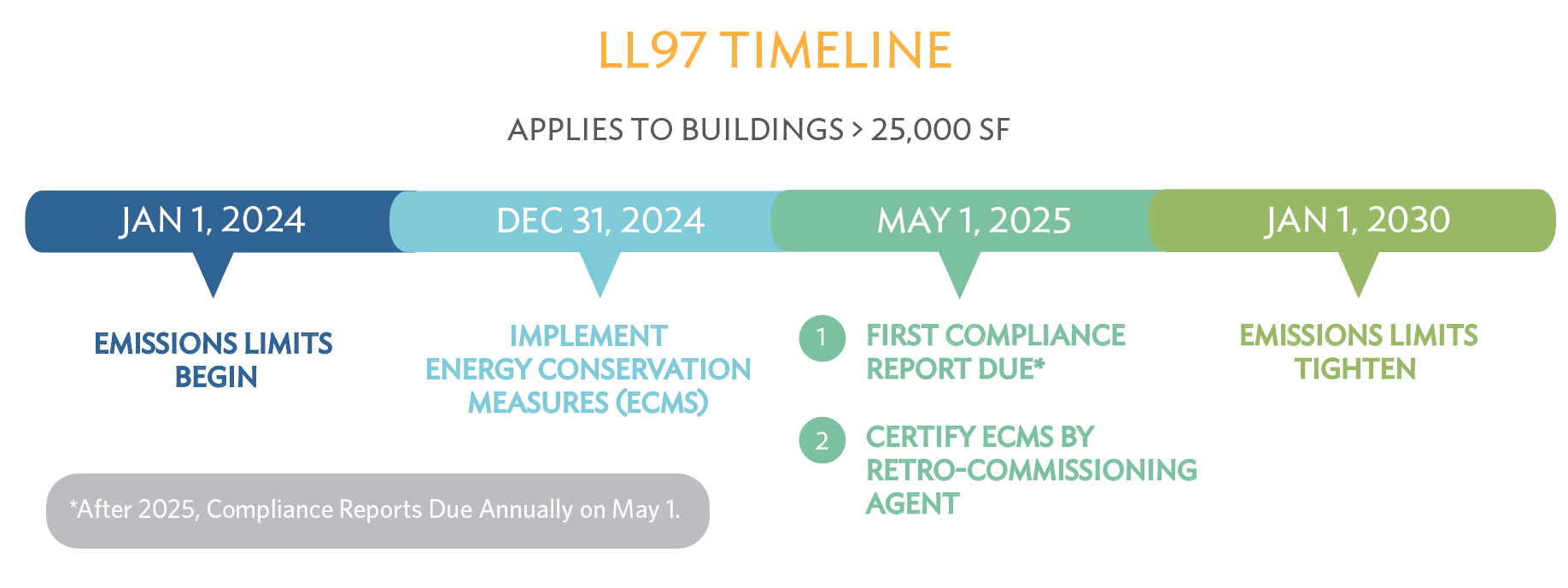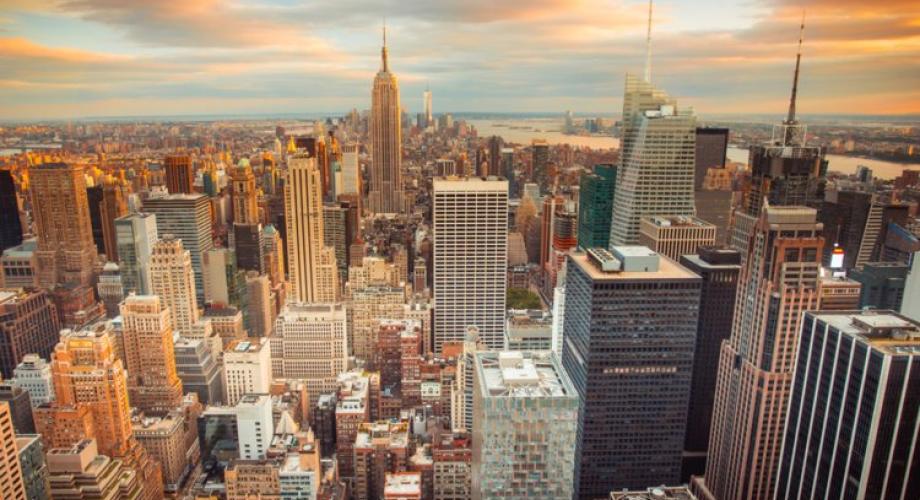Effective November 15, 2019, New York City’s Local Law 97 (LL97) is one of many local climate action laws centered around protecting the environment, and subsequently people from the effects of climate change. LL97 is part of a long string of legislation dedicated to reducing energy use and greenhouse gas emissions from NYC buildings – including but not limited to: LL84, LL87, and now LL154.
- LL84 (2009) – requires annual benchmarking of energy and water efficiency of buildings
- LL87 (2009) – requires energy audits and retro-commissioning of base building systems
- LL154 (2021) – “All-Electric New Construction Law”, limiting the use of substances with certain emission profiles in buildings (starting 2024 for buildings <7 stories and in 2027 for buildings > 7 stories)
According to the Mayor’s Office of Sustainability, over 70% of New York City’s carbon emissions come from buildings. With goals set to reduce carbon emissions in the city by 40% by 2030 and 80% by 2050, building emissions are critical to achieving these levels. The groundbreaking and ambitious requirements of LL97 will fuel and propel these reduction targets.
Which Buildings are Impacted?
Nearly 60% of buildings in New York City are impacted by LL97 requirements. LL97 sets carbon emissions limits and requires annual emissions reporting for the following buildings:
- Greater than 25,000 SF
- Two or more buildings on the same tax lot that together exceed 50,000 SF
- Two or more buildings held in condominium form of ownership that together exceed 50,000 SF
Reporting Requirements and Emission Limits
Starting January 1st, 2024, LL97 requires building energy usage tracking, conversion of that usage into a carbon equivalent value, and division into a per square foot Emissions Intensity value. Building owners must submit an annual emissions report that includes their building’s Emissions Intensity value for the previous calendar year.
Most critically, LL97 defines and sets Emissions Intensity Limits for two upcoming 5-year time periods, with, limits becoming increasingly stringent over each time period. Emissions Intensity Limits also vary and depend on the building’s occupancy group, as defined in the International Building Code. Emissions Intensity Limits are shown by occupancy group in the table and graph below. The first two 5-year periods have been precisely defined, while all future limits are to be set by the city commissioner “in a reasonable time frame”. (Units are in metric tons of CO2e/SF)

The limits per the building’s occupancy group decreases significantly from 2029 to 2030. As shown in the graph below, emissions limits are tightened on average by 56% going into the second 5-year period. Because of this, we recommend that building owners not only consider whether their building emissions will meet compliance for 2024, but also for 2030.

Critical Timelines and Dates
All reporting must be done annually by May 1st for the previous calendar year. The first emissions report is due May 1st, 2025. Each annual report must also be verified and stamped by a “Registered Design Professional”.
Additional requirements include the implementation of Energy Conservation Measures (ECMs). By December 31st, 2024, building owners must implement a list of Prescriptive ECMs (as defined in the local law) that will reduce building energy usage and help the building meet the upcoming emissions limits. The Implementation of ECMs must also be certified by a “Retro-Commissioning Agent” in the first annual report due May 1st, 2025.
Bala is staffed with a team of Registered Design Professionals and Retro-Commissioning Agents to help building owners navigate all steps and actions required by LL97.

The Potentially High Price to Pay
Buildings that don’t meet emissions limits could face significant fines. Penalty for non-compliance is set at $268/metric ton CO2e. Although a seemingly low number, buildings in NYC could see fines over $100,000 per year starting in 2025. The penalty for not submitting a report is set at $.50/SF/month. Inaccurate submissions could face penalties of up to $500,000 or up to 30 days of imprisonment.
Using the latest available public data, Bala has identified nearly 3,000 buildings that will likely exceed emission limits starting in 2024. These non-compliant buildings could rack up a grand sum of over $100M in penalties annually if building owners do not take energy reduction measures.
To avoid costly fines, building owners should report their building emissions accurately and on time, and if needed, implement building energy reduction strategies.
Finding the Right Path
It can be difficult to know where your building stands and what the best course of action is. To help with this, Bala’s LL97 specialists have created a decision tree to help building owners identify the best steps to prepare for the reporting and compliance requirements of LL97.
.png)
Bala can perform initial building estimates, determine projected emissions, and identify whether buildings will fall under or over LL97’s emissions limits.
Regardless of projected emissions, all buildings covered by LL97 must undergo a set of Prescriptive Energy Conservation Measures (ECMs) by December 31st, 2024. ECMs can include, but are not limited to the following:
- “insulating all pipes for heating and/or hot water”
- “weatherizing and air sealing where appropriate, including windows and ductwork, with focus on whole-building insulation”
- “installing indoor and outdoor heating system sensors and boiler controls to allow for proper set-points”.
With Prescriptive ECMs required by the end of 2024, and a Retro-Commissioning Agent certified report due May 1st, 2025 – building owners should start planning now. Bala’s team of engineers can help explore, determine, and implement the best ECMs for buildings, as well as certify ECM reports.
If your building is projected to exceed the 2024 Emissions Intensity Limits, we recommend reviewing previous LL87 Reports to identify energy use and emissions “hot spots” in your building. Depending on how much you are projected to exceed emissions limits, we recommend starting with a robust retro-commissioning study, followed up with potential capital improvements to help meet compliance.
Building owners should consider compliance with the 2030 limits as well. Taking the next decade into consideration, Bala can conduct a Building Carbon Compliance Planning Study, that will help identify optimal times for emissions reductions, based on emissions intensity limits and current/future installed equipment. We believe that having a proactive plan for LL97 will lead to optimal end savings.
Bala’s Tailored LL97 Services
Bala has an experienced team of registered design professionals and retro-commissioning agents that can help building owners prepare for yearly emissions reports, implement energy conservation measures, and pursue emissions reduction strategies.
A holistic plan of action will yield the greatest potential benefit with the lowest associated operational and financial risk. Bala recognizes that every building and building owner is unique. For that reason, we created a process and series of services can be used sequentially or independently:
- Conduct Initial Baseline Emissions Report (before 2024)
- Review of LL87 Report for In-Depth Estimate
- Implement Prescriptive Energy Conservation Measures (ECMs)
- Verify First Emissions Report for Year of 2024 (Due May 1st, 2025)
- Certify Implementation of ECMs (Due May 1st, 2025)
- Perform a Building Carbon Compliance Planning Study (for 2030)
- Retro-Commissioning Study / Energy Audit
- Capital Improvement Project
For questions or interest in initial estimates, contact our LL97 Team:



Christopher Kinlen Bradley Williams Elizabeth Larsen
Commissioning Project Manager Vice President Sustainability Engineer
cjk@bala.com bdw@bala.com ekl@bala.com


